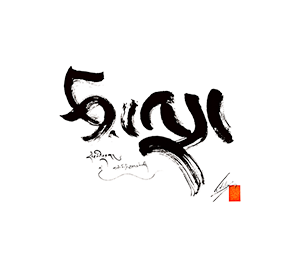Interest in the
Vajrasamādhi has been roused by a paper of Lin Tai-yün published in I932
[1]. In the
Vajrasamādhi Lin had found a quotation from what is generally supposed to be a Bodhidharma text
[2], and thus the problem was set of the relation between these bits of material and the bearing which an investigation into this matter might have on the riddle of Bodhidharma. Suzuki Daisetsu has dealt with this problem in 1936
[3], Paul Demiéville in 1952
[4] and Dr. Mizuno in I955
[5]. I shall in this note confine myself to the text itself.
The texts in question are:
1. Chin-kang san-mei ching (Vajrasamādhi) T. 273 vol. 9. (Quoted in the following as Samādhi.) It has three commentaries:
a. The Chin-kang san-mei ching lun, T. 1730 vol. 37 composed by Yüan-hsiao, a Korean, in the second half of the seventh century. This is the only commentary which I have used for this paper in order to correct the original. A very good modern edition has been published by Chou Shu-chia in Peking 1936.
b. Zokuzōkyō A 55/2-3. Ming.
c. Zokuzōkyō A 55/3. Ch'ing.
2. Chin-kang shang-wei t'o-lo-ni ching, T. 1344 vol. 21. Transl. Buddhaśānta (?). Yüan Wei.
3. Chin-kang ch'ang t'o-lo-ni ching, T. 1345 vol. 21. Transl. Jinagupta (?) (527-604). A second translation of the preceding. These two texts have no relation to the Samādhi.
4. Chin-kang san-nei pen-hsing ch'ing-ching pu-huai pu-mieh ching, T. 644 vol. 15. A probably genuine text, containing 100 samādhis . . . (Liebenthal, opening remarks, 347–48)
[ . . .]
It seems to me established that
The Samādhi is an agglomeration of several texts, of which we have distinguished:
1. A frame (Text A), probably derived from a sūtra translated in the fifth century or earlier in the North, perhaps in Liang-chou. This seems to have been a Hīnayāna text.
2. A text (B), which contains the verses and part of the prose, composed between 565 and 590 by a teacher of the North, Yeh or P'eng-ch'eng. The author might have been Ching-sung.
It is difficult to say how Text B originally looked. Was it a pamphlet or a collection of gleanings from other texts? Was it written to counteract the propaganda of Hui-ssu?
In order to further clarify these points I propose for study: (1) a careful investigation of the northern tradition from Bodhiruci and Buddhaśānta on to about 590 A.D., (2) searching the Tun-huang fragments for parts of the original Text B, (3) further search for quotations in the texts studied by the teachers of the Northern Ch'i. (Liebenthal, conclusion, 383–86).
(*Chinese characters in the original text and notes unavailable)
